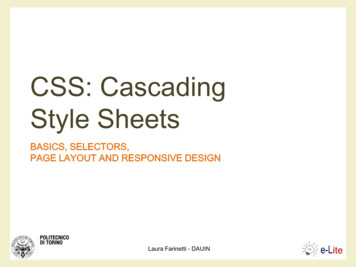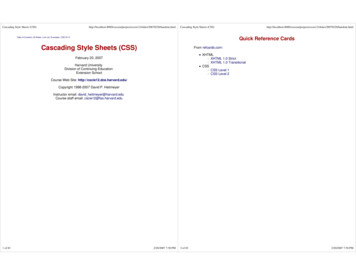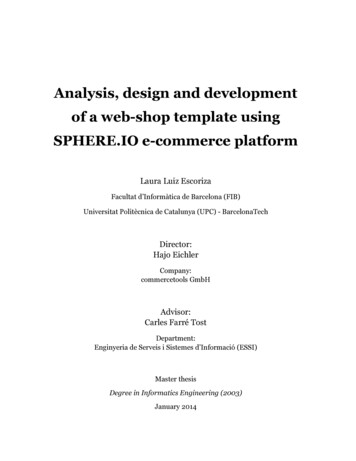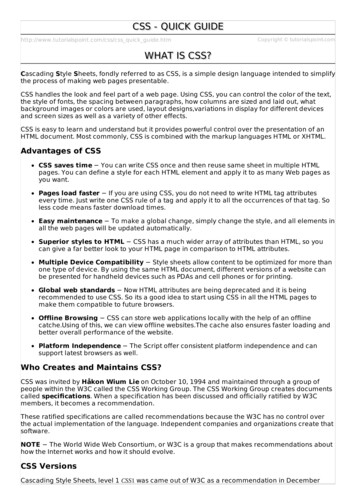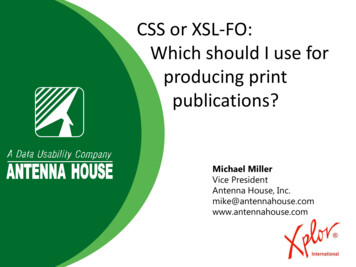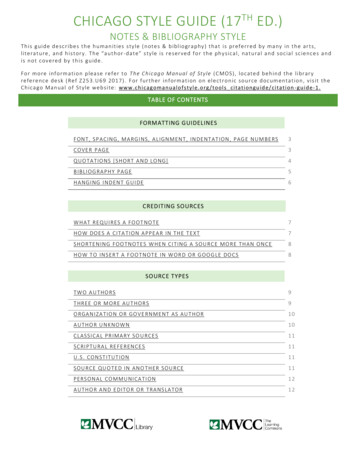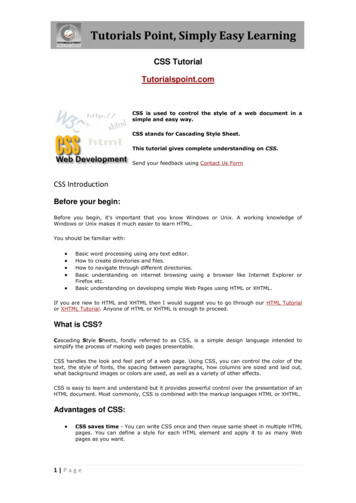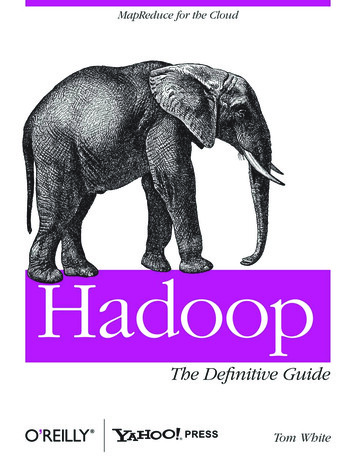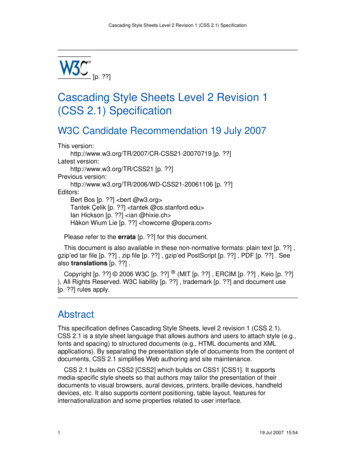
Transcription
Cascading Style Sheets Level 2 Revision 1 (CSS 2.1) Specification[p. ?]Cascading Style Sheets Level 2 Revision 1(CSS 2.1) SpecificationW3C Candidate Recommendation 19 July 2007This 9 [p. ?]Latest version:http://www.w3.org/TR/CSS21 [p. ?]Previous 6 [p. ?]Editors:Bert Bos [p. ?] bert @w3.org Tantek Çelik [p. ?] tantek @cs.stanford.edu Ian Hickson [p. ?] ian @hixie.ch Håkon Wium Lie [p. ?] howcome @opera.com Please refer to the errata [p. ?] for this document.This document is also available in these non-normative formats: plain text [p. ?] ,gzip’ed tar file [p. ?] , zip file [p. ?] , gzip’ed PostScript [p. ?] , PDF [p. ?] . Seealso translations [p. ?] .Copyright [p. ?] 2006 W3C [p. ?] (MIT [p. ?] , ERCIM [p. ?] , Keio [p. ?]), All Rights Reserved. W3C liability [p. ?] , trademark [p. ?] and document use[p. ?] rules apply.AbstractThis specification defines Cascading Style Sheets, level 2 revision 1 (CSS 2.1).CSS 2.1 is a style sheet language that allows authors and users to attach style (e.g.,fonts and spacing) to structured documents (e.g., HTML documents and XMLapplications). By separating the presentation style of documents from the content ofdocuments, CSS 2.1 simplifies Web authoring and site maintenance.CSS 2.1 builds on CSS2 [CSS2] which builds on CSS1 [CSS1]. It supportsmedia-specific style sheets so that authors may tailor the presentation of theirdocuments to visual browsers, aural devices, printers, braille devices, handhelddevices, etc. It also supports content positioning, table layout, features forinternationalization and some properties related to user interface.119 Jul 2007 15:54
Cascading Style Sheets Level 2 Revision 1 (CSS 2.1) SpecificationCSS 2.1 corrects a few errors in CSS2 (the most important being a new definitionof the height/width of absolutely positioned elements, more influence for HTML’s"style" attribute and a new calculation of the ’clip’ property), and adds a few highlyrequested features which have already been widely implemented. But most of allCSS 2.1 represents a "snapshot" of CSS usage: it consists of all CSS features thatare implemented interoperably at the date of publication of the Recommendation.CSS 2.1 is derived from and is intended to replace CSS2. Some parts of CSS2are unchanged in CSS 2.1, some parts have been altered, and some parts removed.The removed portions may be used in a future CSS3 specification. Future specsshould refer to CSS 2.1 (unless they need features from CSS2 which have beendropped in CSS 2.1, and then they should only reference CSS2 for those features,or preferably reference such feature(s) in the respective CSS3 Module that includesthose feature(s)).Status of this documentThis section describes the status of this document at the time of its publication.Other documents may supersede this document. A list of current W3C publicationsand the latest revision of this technical report can be found in the W3C technicalreports index at http://www.w3.org/TR/ [p. ?] .This is a W3C Candidate Recommendation, which means the specification hasbeen widely reviewed and W3C recommends that it be implemented. It will remainCandidate Recommendation at least until 20 December 2007. [p. 3] A test suite anda report on implementations will be provided before the document becomes aProposed Recommendation.Publication as a Candidate Recommendation does not imply endorsement by theW3C Membership. This is a draft document and may be updated, replaced orobsoleted by other documents at any time. It is inappropriate to cite this documentas other than work in progress.The (archived [p. ?] ) public mailing list www-style@w3.org [p. ?] (seeinstructions [p. ?] ) is preferred for discussion of this specification. When sendinge-mail, please put the text “[CSS21]” in the subject, preferably like this: “[CSS21] summary of comment ”A list of changes since the last Working Draft [p. ?] is available in the Dispositionof Comments [p. ?] .This document was produced by the CSS Working Group [p. ?] (part of the StyleActivity [p. ?] ).This document was produced by a group operating under the 5 February 2004W3C Patent Policy [p. ?] . W3C maintains a public list of any patent disclosures[p. ?] made in connection with the deliverables of the group; that page also includesinstructions for disclosing a patent. An individual who has actual knowledge of apatent which the individual believes contains Essential Claim(s) [p. ?] must disclosethe information in accordance with section 6 of the W3C Patent Policy [p. ?] .19 Jul 2007 15:542
Cascading Style Sheets Level 2 Revision 1 (CSS 2.1) SpecificationCandidate Recommendation Exit CriteriaFor this specification to exit the CR stage, the following conditions must be met:1. There must be at least two interoperable implementations for every feature. Forthe purposes of this criterion, we define the following terms:featureA section or subsection of the specification.interoperablepassing the respective test cases in the test suite, or, if theimplementation is not a web browser, equivalent tests. Every relevant testin the test suite should have an equivalent test created if such a UA is to beused to claim interoperability. In addition if such a UA is to be used to claiminteroperability, then there must one or more additional UAs which can alsopass those equivalent tests in the same way for the purpose ofinteroperability. The equivalent tests must be made publicly available forthe purposes of peer review.implementationa user agent which:1. implements the feature.2. is available (i.e. publicly downloadable or available through some otherpublic point of sale mechanism). This is the "show me" requirement.3. is shipping (i.e. development, private or unofficial versions areinsufficient).4. is not experimental (i.e. is intended for a wide audience and could beused on a daily basis).2. A minimum of six months of the CR period must have elapsed. This is to ensurethat enough time is given for any remaining major errors to be caught.3. The CR period will be extended if implementations are slow to appear.4. Features that were not in CSS1 will be dropped (thus reducing the list of "all"features mentioned above) if two or more interoperable implementations ofthose features are not found by the end of the CR period.5. Features will also be dropped if sufficient and adequate tests (by judgment ofthe working group) have not been produced for those features by the end of theCR period.Features at riskThe working group has identified the following features as being currently poorlyimplemented by UAs. They are therefore most at risk of being removed fromCSS 2.1 when exiting CR. (Any changes of this nature will still result in thespecification being returned to last call.) Implementors are urged to implement these319 Jul 2007 15:54
Cascading Style Sheets Level 2 Revision 1 (CSS 2.1) Specificationfeatures, or correct bugs in their implementations, if they wish to see these featuresremain in this specification.New ’list-style-type’ �Implementors are advised to look at CSS3 Lists instead, where these andmany other new values not found in CSS1 are defined in detail. [CSS3LIST]Support for multiple ID attributes for the ID selectorBecause implementations are not expected to support multiple IDs perelement soon, this feature may be made informative. The W3C Selectorsspecification will continue to have this feature normatively. (Section 5.9. [p. 78] )Automatic table layout algorithmThe input to the suggested (non-normative) automatic layout algorithm fortables is restricted to (1) the containing block width and (2) the content andproperties of the table and its children. This restriction may be lifted.QuotesThe ’quotes’ property and the ’open-quote’, ’close-quote’, ’no-open-quote’ and’no-close-quote’ keywords may be dropped.BODY element in XHTMLThe effect of ’overflow’ [p. 185] and ’background’ [p. 221] is different on BODYelements in HTML than on other elements. It may be that the exceptionalhandling of BODY in HTML is extended to BODY in XHTML1.19 Jul 2007 15:544
Cascading Style Sheets Level 2 Revision 1 (CSS 2.1) SpecificationQuick Table of Contents1 About the CSS 2.1 Specification.2 Introduction to CSS 2.1.3 Conformance: Requirements and Recommendations4 Syntax and basic data types.5 Selectors .6 Assigning property values, Cascading, and Inheritance7 Media types.8 Box model.9 Visual formatting model.10 Visual formatting model details.11 Visual effects.12 Generated content, automatic numbering, and lists13 Paged media.14 Colors and Backgrounds .15 Fonts.16 Text .17 Tables.18 User interface.Appendix A. Aural style sheets .Appendix B. Bibliography.Appendix C. Changes.Appendix D. Default style sheet for HTML 4 .Appendix E. Elaborate description of Stacking ContextsAppendix F. Full property table .Appendix G. Grammar of CSS 2.1.Appendix I. .393.19 Jul 2007 15:54
Cascading Style Sheets Level 2 Revision 1 (CSS 2.1) SpecificationFull Table of Contents1 About the CSS 2.1 Specification.1.1 CSS 2.1 vs CSS 2 .1.2 Reading the specification.1.3 How the specification is organized.1.4 Conventions.1.4.1 Document language elements and attributes1.4.2 CSS property definitions .1.4.2.1 Value .1.4.2.2 Initial .1.4.2.3 Applies to .1.4.2.4 Inherited.1.4.2.5 Percentage values .1.4.2.6 Media groups .1.4.2.7 Computed value.1.4.3 Shorthand properties .1.4.4 Notes and examples .1.4.5 Images and long descriptions .1.5 Acknowledgments .2 Introduction to CSS 2.1.2.1 A brief CSS 2.1 tutorial for HTML.2.2 A brief CSS 2.1 tutorial for XML .2.3 The CSS 2.1 processing model .2.3.1 The canvas .2.3.2 CSS 2.1 addressing model.2.4 CSS design principles .3 Conformance: Requirements and Recommendations.3.1 Definitions .3.2 UA Conformance.3.3 Error conditions .3.4 The text/css content type.4 Syntax and basic data types.4.1 Syntax .4.1.1 Tokenization .4.1.2 Keywords.4.1.2.1 Vendor-specific extensions .4.1.2.2 Informative Historical Notes .4.1.3 Characters and case .4.1.4 Statements.4.1.5 At-rules .4.1.6 Blocks.4.1.7 Rule sets, declaration blocks, and selectors19 Jul 2007 3.44.47.47.48.48.49.50.50.51.6
Cascading Style Sheets Level 2 Revision 1 (CSS 2.1) Specification4.1.8 Declarations and properties. 52.4.1.9 Comments. 53.4.2 Rules for handling parsing errors. 53.4.3 Values . 55.4.3.1 Integers and real numbers. 55.4.3.2 Lengths . 55.4.3.3 Percentages . 59.4.3.4 URLs and URIs . 59.4.3.5 Counters . 60.4.3.6 Colors. 61.4.3.7 Strings. 62.4.3.8 Unsupported Values . 63.4.4 CSS style sheet representation . 63.4.4.1 Referring to characters not represented in a character encoding675 Selectors . 69.5.1 Pattern matching. 69.5.2 Selector syntax . 71.5.2.1 Grouping . 71.5.3 Universal selector. 72.5.4 Type selectors . 72.5.5 Descendant selectors. 72.5.6 Child selectors . 73.5.7 Adjacent sibling selectors. 73.5.8 Attribute selectors . 74.5.8.1 Matching attributes and attribute values. 74.5.8.2 Default attribute values in DTDs. 76.5.8.3 Class selectors. 76.5.9 ID selectors . 78.5.10 Pseudo-elements and pseudo-classes . 79.5.11 Pseudo-classes. 80.5.11.1 :first-child pseudo-class . 80.5.11.2 The link pseudo-classes: :link and :visited. 81.5.11.3 The dynamic pseudo-classes: :hover, :active, and :focus . 81.5.11.4 The language pseudo-class: :lang. 83.5.12 Pseudo-elements . 84.5.12.1 The :first-line pseudo-element. 84.5.12.2 The :first-letter pseudo-element . 86.5.12.3 The :before and :after pseudo-elements . 89.6 Assigning property values, Cascading, and Inheritance . 91.6.1 Specified, computed, and actual values . 91.6.1.1 Specified values . 91.6.1.2 Computed values . 92.6.1.3 Used values . 92.719 Jul 2007 15:54
Cascading Style Sheets Level 2 Revision 1 (CSS 2.1) Specification6.1.4 Actual values .6.2 Inheritance .6.2.1 The ’inherit’ value .6.3 The @import rule.6.4 The cascade.6.4.1 Cascading order .6.4.2 !important rules.6.4.3 Calculating a selector’s specificity .6.4.4 Precedence of non-CSS presentational hints .7 Media types.7.1 Introduction to media types .7.2 Specifying media-dependent style sheets.7.2.1 The @media rule .7.3 Recognized media types.7.3.1 Media groups .8 Box model.8.1 Box dimensions .8.2 Example of margins, padding, and borders .8.3 Margin properties: ’margin-top’, ’margin-right’, ’margin-bottom’,’margin-left’, and ’margin’.8.3.1 Collapsing margins.8.4 Padding properties: ’padding-top’, ’padding-right’, ’padding-bottom’,’padding-left’, and ’padding’ .8.5 Border properties.8.5.1 Border width: ’border-top-width’, , ’border-left-width’, and ’border-width’ .8.5.2 Border color: ’border-top-color’, , ’border-left-color’, and ’border-color’.8.5.3 Border style: ’border-top-style’, , ’border-left-style’, and ’border-style’.8.5.4 Border shorthand properties: ’border-top’, ’border-right’,’border-bottom’, ’border-left’, and ’border’.8.6 The box model for inline elements in bidirection context .9 Visual formatting model.9.1 Introduction to the visual formatting model.9.1.1 The viewport .9.1.2 Containing blocks .9.2 Controlling box generation .9.2.1 Block-level elements and block boxes .9.2.1.1 Anonymous block boxes.9.2.2 Inline-level elements and inline boxes .9.2.2.1 Anonymous inline boxes.9.2.3 Run-in boxes .9.2.4 The ’display’ property .19 Jul 2007 .119.119.120.120.121.121.121.123.123.124.124.8
Cascading Style Sheets Level 2 Revision 1 (CSS 2.1) Specification9.3 Positioning schemes. 126.9.3.1 Choosing a positioning scheme: ’position’ property . 126.9.3.2 Box offsets: ’top’, ’right’, ’bottom’, ’left’ . 128.9.4 Normal flow . 130.9.4.1 Block formatting contexts . 130.9.4.2 Inline formatting context . 130.9.4.3 Relative positioning. 133.9.5 Floats . 134.9.5.1 Positioning the float: the ’float’ property. 138.9.5.2 Controlling flow next to floats: the ’clear’ property . 140.9.6 Absolute positioning . 141.9.6.1 Fixed positioning . 142.9.7 Relationships between ’display’, ’position’, and ’float’ . 143.9.8 Comparison of normal flow, floats, and absolute positioning . 144.9.8.1 Normal flow . 145.9.8.2 Relative positioning. 145.9.8.3 Floating a box. 146.9.8.4 Absolute positioning . 149.9.9 Layered presentation. 153.9.9.1 Specifying the stack level: the ’z-index’ property. 153.9.10 Text direction: the ’direction’ and ’unicode-bidi’ properties. 155.10 Visual formatting model details. 161.10.1 Definition of "containing block" . 161.10.2 Content width: the ’width’ property . 164.10.3 Calculating widths and margins . 165.10.3.1 Inline, non-replaced elements. 166.10.3.2 Inline, replaced elements. 166.10.3.3 Block-level, non-replaced elements in normal flow. 166.10.3.4 Block-level, replaced elements in normal flow . 167.10.3.5 Floating, non-replaced elements . 167.10.3.6 Floating, replaced elements . 167.10.3.7 Absolutely positioned, non-replaced elements. 168.10.3.8 Absolutely positioned, replaced elements . 169.10.3.9 ’Inline-block’, non-replaced elements in normal flow . 169.10.3.10 ’Inline-block’, replaced elements in normal flow . 170.10.4 Minimum and maximum widths: ’min-width’ and ’max-width’ . 170.10.5 Content height: the ’height’ property. 172.10.6 Calculating heights and margins. 174.10.6.1 Inline, non-replaced elements. 174.10.6.2 Inline replaced elements, block-level replaced elements innormal flow, ’inline-block’ replaced elements in normal flow and floatingreplaced elements . 175.10.6.3 Block-level non-replaced elements in normal flow when919 Jul 2007 15:54
Cascading Style Sheets Level 2 Revision 1 (CSS 2.1) Specification’overflow’ computes to ’visible’ . 175.10.6.4 Absolutely positioned, non-replaced elements. 176.10.6.5 Absolutely positioned, replaced elements . 177.10.6.6 Complicated cases . 177.10.6.7 ’Auto’ heights for block formatting context roots . 178.10.7 Minimum and maximum heights: ’min-height’ and ’max-height’ . 178.10.8 Line height calculations: the ’line-height’ and ’vertical-align’ properties18010.8.1 Leading and half-leading . 180.11 Visual effects. 185.11.1 Overflow and clipping . 185.11.1.1 Overflow: the ’overflow’ property . 185.11.1.2 Clipping: the ’clip’ property. 188.11.2 Visibility: the ’visibility’ property . 190.12 Generated content, automatic numbering, and lists. 193.12.1 The :before and :after pseudo-elements. 193.12.2 The ’content’ property . 195.12.3 Quotation marks. 197.12.3.1 Specifying quotes with the ’quotes’ property . 197.12.3.2 Inserting quotes with the ’content’ property. 199.12.4 Automatic counters and numbering . 200.12.4.1 Nested counters and scope . 202.12.4.2 Counter styles . 203.12.4.3 Counters in elements with ’display: none’ . 204.12.5 Lists . 204.12.5.1 Lists: the ’list-style-type’, ’list-style-image’, ’list-style-position’,and ’list-style’ properties. 205.13 Paged media. 211.13.1 Introduction to paged media. 211.13.2 Page boxes: the @page rule. 212.13.2.1 Page margins. 212.13.2.1.1 Rendering page boxes that do not fit a target sheet . 214.13.2.1.2 Positioning the page box on the sheet . 214.13.2.2 Page selectors: selecting left, right, and first pages. 214.13.2.3 Content outside the page box. 215.13.3 Page breaks . 215.13.3.1 Page break properties: ’page-break-before’, ’page-break-after’,’page-break-inside’ . 215.13.3.2 Breaks inside elements: ’orphans’, ’widows’ . 217.13.3.3 Allowed page breaks. 218.13.3.4 Forced page breaks . 218.13.3.5 "Best" page breaks . 218.13.4 Cascading in the page context . 219.14 Colors and Backgrounds . 221.19 Jul 2007 15:5410
Cascading Style Sheets Level 2 Revision 1 (CSS 2.1) Specification14.1 Foreground color: the ’color’ property. 221.14.2 The background. 221.14.2.1 Background properties: ’background-color’, ’background-image’,’background-repeat’, ’background-attachment’, ’background-position’,and ’background’. 222.14.3 Gamma correction . 228.15 Fonts. 231.15.1 Introduction. 231.15.2 Font matching algorithm. 231.15.3 Font family: the ’font-family’ property. 232.15.3.1 Generic font families . 234.15.3.1.1 serif . 234.15.3.1.2 sans-serif . 235.15.3.1.3 cursive. 236.15.3.1.4 fantasy. 236.15.3.1.5 monospace. 236.15.4 Font styling: the ’font-style’ property. 237.15.5 Small-caps: the ’font-variant’ property . 237.15.6 Font boldness: the ’font-weight’ property. 238.15.7 Font size: the ’font-size’ property. 241.15.8 Shorthand font property: the ’font’ property . 242.16 Text . 245.16.1 Indentation: the ’text-indent’ property. 245.16.2 Alignment: the ’text-align’ property . 246.16.3 Decoration . 247.16.3.1 Underlining, overlining, striking, and blinking: the’text-decoration’ property. 247.16.4 Letter and word spacing: the ’letter-spacing’ and ’word-spacing’properties . 249.16.5 Capitalization: the ’text-transform’ property . 251.16.6 Whitespace: the ’white-space’ property . 252.16.6.1 The ’white-space’ processing model . 253.16.6.2 Example of bidirectionality with white-space collapsing. 254.16.6.3 Control and combining characters’ details. 254.17 Tables. 255.17.1 Introduction to tables . 255.17.2 The CSS table model . 257.17.2.1 Anonymous table objects. 259.17.3 Columns . 260.17.4 Tables in the visual formatting model. 261.17.4.1 Caption position and alignment . 262.17.5 Visual layout of table contents . 263.17.5.1 Table layers and transparency. 264.17.5.2 Table width algorithms: the ’table-layout’ property . 267.1119 Jul 2007 15:54
Cascading Style Sheets Level 2 Revision 1 (CSS 2.1) Specification17.5.2.1 Fixed table layout .17.5.2.2 Automatic table layout .17.5.3 Table height algorithms .17.5.4 Horizontal alignment in a column .17.5.5 Dynamic row and column effects .17.6 Borders.17.6.1 The separated borders model.17.6.1.1 Borders and Backgrounds around empty cells: the’empty-cells’ property .17.6.2 The collapsing border model .17.6.2.1 Border conflict resolution .17.6.3 Border styles.18 User interface.18.1 Cursors: the ’cursor’ property .18.2 System Colors .18.3 User preferences for fonts .18.4 Dynamic outlines: the ’outline’ property .18.4.1 Outlines and the focus.18.5 Magnification .Appendix A. Aural style sheets .A.1 The media types ’aural’ and ’speech’.A.2 Introduction to aural style sheets.A.2.1 Angles.A.2.2 Times.A.2.3 Frequencies .A.3 Volume properties: ’volume’ .A.4 Speaking properties: ’speak’.A.5 Pause properties: ’pause-before’, ’pause-after’, and ’pause’ .A.6 Cue properties: ’cue-before’, ’cue-after’, and ’cue’.A.7 Mixing properties: ’play-during’ .A.8 Spatial properties: ’azimuth’ and ’elevation’ .A.9 Voice characteristic properties: ’speech-rate’, ’voice-family’, ’pitch’,’pitch-range’, ’stress’, and ’richness’ .A.10 Speech properties: ’speak-punctuation’ and ’speak-numeral’.A.11 Audio rendering of tables .A.11.1 Speaking headers: the ’speak-header’ property .A.12 Sample style sheet for HTML .A.13 Emacspeak.Appendix B. Bibliography.B.1 Normative references.B.2 Informative references .Appendix C. Changes.C.1 Additional property values .19 Jul 2007 09.309.311.313.320.12
Cascading Style Sheets Level 2 Revision 1 (CSS 2.1) SpecificationC.1.1 Section 4.3.6 Colors .C.1.2 Section 9.2.4 The ’display’ property.C.1.3 Section 12.2 The ’content’ property.C.1.4 Section 16.6 Whitespace: the ’white-space’ property .C.1.5 Section 18.1 Cursors: the ’cursor’ property.C.2 Changes.C.2.1 Section 1.1 CSS 2.1 vs CSS 2.C.2.2 Section 1.2 Reading the specification .C.2.3 Section 1.3 How the specification is organized .C.2.4 Section 1.4.2.1 Value .C.2.5 Section 1.4.2.6 Media groups .C.2.6 Section 1.4.2.7 Computed value .C.2.7 Section 1.4.4 Notes and examples.C.2.8 Section 1.5 Acknowledgements.C.2.9 Section 3.2 Conformance .C.2.10 Section 3.3 Error Conditions .C.2.11 4.1.1 Tokenization .C.2.12 4.1.3 Characters and case .C.2.13 Section 4.2 Rules for handling parsing errors .C.2.14 Section 4.3 Values .C.2.15 Section 4.3.2 Lengths.C.2.16 Section 4.3.4 URLs and URIs.C.2.17 Section 4.3.6 Colors .C.2.18 Section 4.3.8 Unsupported Values.C.2.19 Section 4.4 CSS style sheet representation .C.2.20 Section 5.8.1 Matching attributes and attribute values.C.2.21 Section 5.8.3 Class selectors.C.2.22 Section 5.9 ID selectors .C.2.23 Section 5.10 Pseudo-elements and pseudo-classes .C.2.24 5.11.2 The link pseudo-classes: :link and :visited .C.2.25 Section 5.11.4 The language pseudo-class: :lang.C.2.26 Section 5.12.1 The :first-line pseudo-element.C.2.27 Section 5.12.2 The :first-letter pseudo-element.C.2.28 Section 6.1 Specified, computed, and actual values .C.2.29 Section 6.4.1 Cascading order .C.2.30 Section 6.4.3 Calculating a selector’s specificity .C.2.31 Section 6.4.4 Precedence of non-CSS presentational hintsC.2.32 Section 7.3 Recognized Media Types.C.2.33 Section 7.3.1 Media Groups .C.2.34 Section 8.3 Margin properties.C.2.35 Section 8.3.1 Collapsing margins.C.2.36 Section 8.4 Padding properties .C.2.37 Section 8.5.2 Border 5.325.325.325.325.325.326.326.19 Jul 2007 15:54
Cascading Style Sheets Level 2 Revision 1 (CSS 2.1) SpecificationC.2.38 Section 8.5.3 Border style. 326.C.2.39 Section 8.6 The box model for inline elements in bidirectioncontext . 326.C.2.40 Section 9.1.2 Containing blocks . 326.C.2.41 Section 9.2.1.1 Anonymous block boxes . 326.C.2.42 Section 9.2.2.1 Anonymous inline boxes . 326.C.2.43 Section 9.2.3 Run-in boxes . 326.C.2.44 Section 9.2.4 The ’display’ property . 327.C.2.45 Section 9.3.1 Choosing a positioning scheme. 327.C.2.46 Section 9.3.2 Box offsets. 327.C.2.47 Section 9.4.1 Block formatting contexts . 327.C.2.48 Section 9.4.2 Inline formatting context. 327.C.2.49 Section 9.4.3 Relative positioning. 328.C.2.50 Section 9.5 Floats . 328.C.2.51 Section 9.5.1 Positioning the float. 328.C.2.52 Section 9.5.2 Controlling flow next to floats . 328.C.2.53 Section 9.7 Relationships between ’display’, ’position’, and’float’ . 328.C.2.54 Section 9.9 Layered presentation. 329.C.2.55 Section 9.10 Text direction . 329.C.2.56 Chapter Visual formatting model details . 329.C.2.57 Section 10.1 Definition of "containing block" . 329.C.2.58 Section 10.2 Content width . 330.C.2.59 Section 10.3 Calculating widths and margins . 330.C.2.60 Section 10.3.2 Inline, replaced elements . 330.C.2.61 Section 10.3.3 Block-level, non-replaced elements in normalflow. 330.C.2.62 Section 10.3.4 Block-level, replaced elements in normal flow330.C.2.63 Section 10.3.5 Floating, non-replaced elements . 330.C.2.64 Section 10.3.6 Floating, replaced elements . 330.C.2.65 Section 10.3.7 Absolutely positioned, non-replaced elements331.C.2.66 Section 10.3.8 Absolutely positioned, replaced elements . 331.C.2.67 Section 10.4 Minimum and maximum widths . 331.C.2.68 Section 10.5 Content height . 331.C.2.69 Section 10.6 Calculating heights and margins. 332.C.2.70 Section 10.6.1 Inline, non-replaced elements . 332.C.2.71 Section 10.6.2 Inline replaced elements, block-level replacedelements in normal flow, ’inline-block’ replaced elements in normal flowand floating replaced elements . 332.C.2.72 Section 10.6.3 Block-level non-replaced elements in normalflow when ’overflow’ computes to ’visible’. 332.C.2.73 Section 10.6.4 Absolutely positioned, non-replaced elements332.C.2.74 Section 10.6.5 Absolutely positioned, replaced elements . 333.C.2.75 Section 10.7 Minimum and maximum heights. 333.19 Jul 2007 15:5414
Cascading Style Sheets Level 2 Revision 1 (CSS 2.1) SpecificationC.2.76 Section 10.8 Line height calculations . 333.C.2.77 Section 10.8.1 Leading and half-leading . 333.C.2.78 Section 11.1 Overflow and clipping . 333.C.2.79 Section 11.1.1 Overflow . 333.C.2.80 Section 11.1.2 Clipping: the ’clip’ property. 334.C.2.81 Section 11.2 Visibility. 334.C.2.82 Chapter 12 Generated content, automatic numbering, and lists334C.2.83 Section 12.1 The :before and :after pseudo-elements . 334.C.2.84 Section 12.2 The ’content’ property . 334.C.2.85 Section 12.3.2 Inserting quotes with the ’content’ property 335.C.2.86 Section 12.4 Automatic counters and numbering . 335.C.2.87 Section 12.4.1 Nested counters and scope . 335.C.2.88 Section 12.5 Lists. 335.C.2.89 Section 12.5.1 Lists . 335.C.2.90 Chapter 13 Paged media. 335.C.2.91 Section 13.2.2 Page selectors. 336.C.2.92 Section 13.3.1 Page break properties. 336.C.2.93 Section 13.3.3 Allowed page breaks . 336.C.2.94 Section 14.2.1 Background properties.
CSS 2.1 represents a "snapshot" of CSS usage: it consists of all CSS features that are implemented interoperably at the date of publication of the Recommendation. CSS 2.1 is derived from and is intended to replace CSS2. Some parts of CSS2 are unchanged in CSS 2

